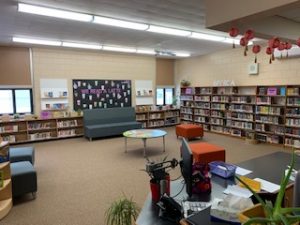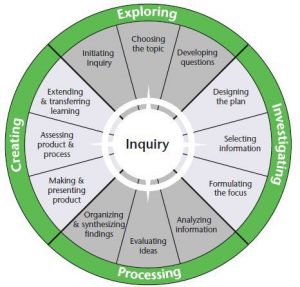Learning Log 4
- Identify and discuss the most important design element that can be implemented in a school library learning commons to optimally enhance inquiry-based learning. Provide a source to support your idea if possible.
The primary goal of any library design element is that it must meet the immediate and future needs of the library users. Once the needs of the users are determined, the design elements can be implemented to effectively become a useful and workable space. The design elements that I feel are most important and encourage inquiry-based learning is that of a collaborative space that encompasses a mix of the physical with moveable furniture and the virtual with access to technology. This is supported by Lippman in the article entitled Collaborative Spaces, Thoughtfully designed learning environments help students work together more effectively.
“The physical environment, the special design, and the information technologies must be planned to support a variety of collaboration spaces. When designed thoughtfully, these spaces help create optimal experiences for learning.” (Lippman, 2013)
A collaborative space encourages inquiry-based learning and a design that inspires and motivates users. It is a flexible and fluid space that offers a design that encourages creative and critical thinking. The space should allow the students to communicate freely, engage with each other and offer multiple areas where students have the choice in how they work.

The space should encourage users to work as a community, allow for partner work as well as room for students to work independently. The space must encourage collaboration. It is the design of the library learning common (LLC) that will determine if the users will be able to fully engage and participate in activities. This is supported by Lippman in the article entitled Collaborative Spaces:
“Thoughtfully designed learning environments help students work together more effectively.” (Lippman, 2013)
The collaborative space must be designed to accommodate inquiry-based learning with larger open areas where students can come together as a large group as well as provide comfortable spaces for individual work. The LLC at my current school provides a flexible design that allows for a variety of learning styles and situations. Teachers can access resources and use the space to facilitate inquiry-based learning activities. The furniture in the LLC plays an important role in creating a workable space. The space has a variety of fixed and unfixed features such as moveable tables and chairs. The table can be placed together to accommodate larger groups of teachers or students or can be moved apart and separated to create an open area or work surfaces for smaller groups. The bookshelves are placed along the outside walls of the LLC with two moveable bookshelves on wheels that can be moved to create an open space or to create a private section of the room. There are two moveable couches with pillows that provide a comfortable space for students to work and read, and three large windows allowing natural light to enter. The windows are also equipped with blackout shades, cutting the light to create an optimal viewing environment.

 My current school library learning common.
My current school library learning common.
The LLC is also equipped with a low-to-the-floor round table which can be used for small group activities with younger children. There is a u-shaped table as well, used to accommodate small group discussions and activities between teacher and students. A whiteboard/screen and projector on one side of the room allows for more than one focal point in the room. It is used by teachers and students alike for multi-media presentations. There is a bulletin board on the wall used for posting information and displaying student work. The space can be arranged to accommodate multiple learning environments and allows the student to work in a variety of social grouping. There are no fixed computers in the room, but students and teachers have access to a computer cart with 25 laptop computers,10 tablets, and digital access to WorldBook Online encyclopedia, Universalis Junior French digital encyclopedia, a green screen, TumbleBooks library, EBSCOHost database, and La Liberté French online newspaper. The LLC space’s versatility has allowed for one-to-one, small group, and large group teaching, research sessions, community social gatherings, staff meetings, PD events, science expositions, guest speaker presentations, student research, clubs, class library period, and many other events.
Video by bythebrooks.ca
The following resource “Reimagining Library Spaces, Transforming Your Space on Any Budget” by Diana Rendina offers information, steps, and practical suggestions for re-designing an LLC on both the large and small scale level.
Resource:

image by renovatedlearning.com
ISBN: 9781564843913
Published: October 2017
Length: 176 pages
Table of contents: https://cdn.iste.org/www-root/conference_med/TOC/TOC-4005.pdf
- Discuss the aspects of inquiry design (or re-design) that you find the most rewarding and the most challenging.
Through inquiry-based learning, students show increased engagement, develop teamwork skills, and are led to a better understanding of information. Inquiry-based learning allows the students the freedom to explore what they are interested in learning, leading to better acquisition of 21st-century skills that will benefit them in their life after school. Inquiry-based learning promotes deeper thinking skills in students.
I feel that the most challenging part of inquiry design is what Barbara Stripling calls the Wonder stage where students are asked to generate possible questions for research. Jean Donham describes this aspect of inquiry as active intellectual exploration. What I find difficult is leading the students to ask the right questions and to think on a deeper level. Donham explains that:
“Posing questions lies at the heart of any inquiry-based assignment.” (Donham, 2011)
This is a very important step in the inquiry process. Teachers must lead the students to develop research questions as opposed to fact-gathering questions. I will have to provide planned opportunities and model good the types of questions that require deeper thinking. I understand the importance of allowing the students the freedom to ask questions. I am concerned that the process may highlight the academic levels of the lower achievers. Creating a culture of inquiry is essential in helping the students to grow into creative and critical thinkers. The process of leading the students to ask good questions comes from an established culture of inquiry. My concern is how well they are able to ask the deeper-level questions that guide the inquiry process. It will require a change in my teaching where other teachers may have already done so. It will require making the shift to using inquiry strategies on a regular basis. This will mean letting go of the reins and allowing the student to use precious time to get on and off track. This will mean having less control over the lesson and the expected outcomes. In general, what is challenging, is the scope of the commitment to taking on inquiry-based learning.
“All across the country educators are working toward inquiry. It may seem as if other people have this transformation down pat and are way ahead of you. Don’t get discouraged.” (Maniotes and Kuhlthau, 2014)
Although inquiry-based learning requires teachers to make big changes to their professional practices which to some, can be a daunting task, there are many rewarding aspects of the implementation of inquiry-based learning. What I find most rewarding is seeing the students showing a high level of engagement and success. As a teacher, this is one of my main goals. A lot of satisfaction comes from seeing the students being successful and demonstrating an enjoyment in learning. Through inquiry-based learning, the students are driven to satisfy and quench their thirst for knowledge. Learning becomes more meaningful to them and allows them to take hold of their own learning. They get excited about a topic that they can explore on their own, in a supportive environment. This is supported by Maniotes and Kuhlthau in their article entitled The Shift, From Traditional Research Assignments to Guiding Inquiry Learning.
“Inquiry provides the emotional satisfaction of building personal knowledge and sharing learning. Studies found that students’ interest increased when they build personal knowledge and that they experience emotional satisfaction in sharing their learning with others in the class.” (Maniotes and Kuhlthau, 2014)
video by https://www.youtube.com/watch?v=QlwkerwaV2E John Spenser
- Use your own information search process to identify an additional inquiry model. Discuss the additional model and compare it to one of the three Canadian models listed in Module 9.
5E’s Inquiry-based learning model
The 5E Inquiry-Based Instructional Model promotes collaborative learning in students and encourages them to investigate new concepts, develop relevant questions, make observations, analyze new information, draw conclusions, and solve problems. Students are encouraged to choose topics that are meaningful to them that allow them to draw upon previous knowledge. The model leads students through 5 phases of inquiry: Engage, Explore, Explain, Elaborate, and Evaluate. The first three sections (Engage, Explore, and Explain) encourage the students to acquire and make meaning of new knowledge. The last two E’s (Elaborate and Evaluate) encourage students to apply, self and peer assess what they have learned.
 image by knowledgequest.aasl.org
image by knowledgequest.aasl.org

image by thelibrarymarketplace.com
5E’s Inquiry-based learning model (5E model): Engage, Explore, Explain, Elaborate and Evaluate
vs.
Ontario School Library Association Together for Learning Model for Inquiry (OSLA model): Exploring, Investigating, Processing, Creating
The initial sections in the 5E model (Engage) and the OSLA model (Exploring) both indicate that in these phases, the teacher will introduce the topic. The teacher works to assess the needs of the students, their prior knowledge, and interests. The students and teacher will choose a topic, discover opening questions, introduce concepts, and encourage an interest in the topic. One of the differences between the two models in these phases is that the Explore section of the OSLA model encourages students to share their thinking with their peers and teachers whereas this is encouraged in the second phase of the 5E model: Explore. The Exploring section of the OSLA model focuses more on modeling and giving descriptive feedback.
The Explore phase of the 5E model is much like the Investigating phase of the OSLA model. The main ideas of these two phases are to formulate a focus by investigating, drawing on prior knowledge, and making predictions and observations. These phases allow the student to create ideas and formulate a plan for inquiry. Here the students will clarify and extend their questions. Students will explore new concepts through learning experiences. The teacher’s role is to challenge the student’s prior knowledge and beliefs and extend their thinking with open-ended questions.
The Processing phase of the OSLA model draws upon many similarities as both the Explain and Elaborate phases of the 5E model. Students will evaluate ideas, analyze, and synthesize ideas, evaluate information connecting it to big ideas, draw conclusions, and compare. Here students identify biases and develop a balanced perspective. In this phase, teachers will assist students with prompts to boost understanding.

The OSLA model contains a Creating phase where students communicate their learning through presentations. Students will plan ways to express their learning and consider a variety of representations. They will pose new and deeper questions and celebrate the learning journey. It is through this phase that teachers will challenge and extend student understanding. The 5E model incorporates these same elements but they are found in the Elaborate phase.
The 5E model contains a section entitles Evaluation. In this phase, the teacher will perform formal and informal assessments. The teacher will make observations to determine if the students have a strong grasp of core concepts. In the Evaluation phase of the 5E model, the student will self-assess whereas the same objective is met in the Creating phase of the OSLA model. The main difference is that assessment and evaluation. Assessment mostly happens at the end of the inquiry process in the 5E model whereas there is more ongoing assessment and reflection throughout the entire inquiry process in the OSLA model.
Both inquiry models are very similar regarding the general criteria of the inquiry process. Both models outlined the importance of learning through activities and the process. They are different in the way the information is presented and organized. The biggest difference is the information given around reflection, evaluation, and assessment. The OSLA model encourages ongoing assessment as opposed to the 5E model highlighting it at the end of the inquiry process. My preference would be to use the OSLA model as it offers much more information about the roles of the student, teacher, and teacher-librarian as a partner and as a leader. The OSLA model also explains student feelings related to inquiry adapted by Kulthau’s research. Through the OSLA website, I was able to access elementary and secondary sample activities and ideas for assessment tools for each phase of the model.
Lippman, P. C. (2013). Collaborative spaces Links to an external site.. T H E Journal 40(1): 32-37.
https://youtu.be/LglFl1BYfFs video by bythebrooks.ca
“Learning Commons Day Winnipeg.” By the Brooks: Anita Brooks Kirkland, www.bythebrooks.ca/presentations/presentations-archive/learning-commons-day-winnipeg/
“Learn about BSCS’s 5E Instructional Model.” BSCS Science Learning, bscs.org/bscs-5e-instructional-model/.
http://www.togetherforlearning.ca/wp-content/uploads/2016/10/INQUIRY-POSTER-English-Linked1.pdf
Northern, Sam. “The 5 E’s of Inquiry-Based Learning.” Knowledge Quest, 27 Aug. 2019, www.knowledgequest.aasl.org/the-5-es-of-inquiry-based-learning/
Donham, J. (2011). Assignments worth doingLinks to an external site.. School Library Monthly. 28(2): 5-7.
Fontichiaro, K. (2009). Re-envisioning existing research projectsLinks to an external site.. School Library Monthly 26(1): 17-19.
Lippman, P. C. (2013). Collaborative spacesLinks to an external site.. T H E Journal 40(1): 32-37.
Steps to designing inquiry-based unitsLinks to an external site.. (2008). School Library Media Activities Monthly 25(3): 2.
Stripling, B. K. & Harada, V. H.. (2012b). Designing learning experiences for deeper Callison, D. & Baker, K. (2015). Elements of information inquiry, evolution of models, & measured reflectionLinks to an external site.. Knowledge Quest 43(2): 18-24.
understandingLinks to an external site.. School Library Monthly, 29(3): 5-12.
